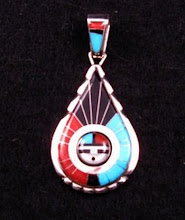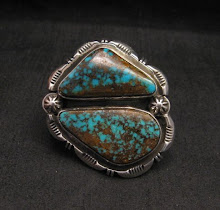Happy Holidays Everyone!
Free U.S.P.S. Priority Mail Shipping for all Native American jewelry purchases through December 25, 2010.
Visit www.tumbleweedsjewelry.com and also our Ebay store to see our complete selection of contemporary, vintage and dead pawn Native American Navajo, Zuni, Hopi & Santo Domingo Indian jewelry.
Saturday, November 20, 2010
Free Holiday Shipping from Tumbleweeds Jewelry
Tuesday, August 10, 2010
Featured Artist - Joseph Coriz, Santo Domingo (Kewa)

The work of Santo Domingo silversmith Joseph Coriz is very distinctive and easily recognizable. He works primarily with sterling silver, rolled heishi beads, turquoise, coral and handmade silver beads. He creates some of the finest jewelry available today. We would like to highlight his work for you here.
Joseph Coriz is a Native American Indian who was born into the Santo Domingo Pueblo in 1958. He was inspired to follow in the footsteps of his parents, who were very successful at making beautiful handmade jewelry, and Videl Aragon, who was known for his fine silversmith petroglyph designs. They taught him all the fundamentals of working with beads and raw silver at a very young age. Joseph absorbed each piece of information about the traditional hand crafted jewelry and eventually developed his own style. He combines traditional methods with his own unique contemporary flare creating primarily sterling silver designs. He creates beautiful masterpieces of fine jewelry and has become one of the finest master silversmiths of our time.
Awards: Santa Fe Indian Market, Eight Northern Pueblo Art Show, Colorado Springs Art Show, New Mexico State Fair, Heard Museum Art SHow.
Wednesday, March 24, 2010
Clayton Tom's Cosmic Bear Pendant

The Cosmic Bear was first introduced by Navajo Calvin Begay and Clayton Tom in the 1990's. The design became so popular, it has been copied again and again by many other Native American artists. But this pendant pictured here is a brand new, original, handmade piece by Clayton Tom, purchased directly from the artist himself. Clayton's jewelry has consistently earned him top awards at major jewelry art shows and Indian markets and led to his recognition as one of the great masters of micro-inlay design and technique. His jewelry is always in big demand, frequently in short supply and often hard to find.
Thursday, March 4, 2010
Buying Authentic Native American Jewelry
Here are a few helpful educational websites with information for the Native American Jewelry buyer. The first is a link to a page on the Indian Arts & Crafts Association's website, entitled Tips For Consumers From their website: "IACA is a international not-for-profit trade association established in 1974 to support the ethical promotion and protection of authentic Native American art and culture. IACA works to stop fraud and abuse within the market through education, publicity, authentication and use of our logo to indicate certified ethical businesses. IACA sponsors the largest wholesale trade shows of handmade Indian art in the world twice a year. IACA's membership represents every link in the arts industry – from Native artists from the U.S. and Canada, to collectors, retailers, wholesalers, museums, government agencies, suppliers and other supporters of Native art." I am currently a member in good standing of IACA.
Here is another helpful Native American Jewelry buyers guide prepared by & provided under a cooperative agreement between the Better Business Bureau and the U. S. Federal Trade Commission (FTC). Entitled How to Buy Genuine American Indian Arts & Crafts, this article reinforces how important it is to trust the seller you are purchasing your Native American Indian Jewelry from. Make sure you are dealing with a seller who is informed, educated and who guarantees the authenticity of the jewelry you are buying.
My family has dealt in Native American and other antiquities for over 90 years, and I have specialized in Indian Jewelry for more than 20 years. I am in full compliance with the US Dept. of the Interior American Indian Arts & Crafts Act of 1990. And finally, I am a proud member of the Indian Arts and Crafts Association (IACA). This insures the authenticity of the jewelry I sell and protects your investment.
I make frequent trips to New Mexico and Arizona to hand select the jewelry we offer for sale on our website www.tumbleweedsjewelry.com. I buy directly from many of the artists or I buy through well respected traders who deal directly with the artists. As a member of the Indian Arts & Crafts Association, I attend the annual buyer's markets where I get to meet more artists every year. I enjoy promoting the work of the artists that I have personally met.
Read How to Buy Genuine American Indian Arts & Crafts
or IACA's Tips For Consumers now.
Sunday, January 31, 2010
Bracelet Sizing Guidelines - How to determine your bracelet size
If you don't have a cuff bracelet to use for comparison, then follow this method:
- First measure your wrist where you want to wear the bracelet.
- Then look at the bracelet you are interested in and add: the inside measurement from end to end plus the gap.
- If the two measurements are fairly close, the bracelet should fit properly. How well it will fit will depend on whether you like to wear your cuff bracelet tight or loose, alone or with other bracelets, in front of or behind the prominent bone on your wrist. Therefore, you may want to add 1/2 inch to 1 inch to the measurement depending upon these variables.
Many cuff bracelets are adjustable. They can be opened or closed up to about a 1/2 inch larger or smaller, depending upon the sturdiness of the bracelet. The types that are not easily adjustable are those that are made from very thick, heavy silver. CAUTION: Bracelets with inlaid stones across the entire front and sides should never be adjusted...at all.
To adjust your bracelet, be very careful how you adjust it so you don't damage it. If you try to bend an area of your bracelet where there is a stone or inlay, the stone may pop out or inlay may crack.
Visit www.tumbleweedsjewelry.com for a great selection of Native American hand made sterling silver bracelets!







